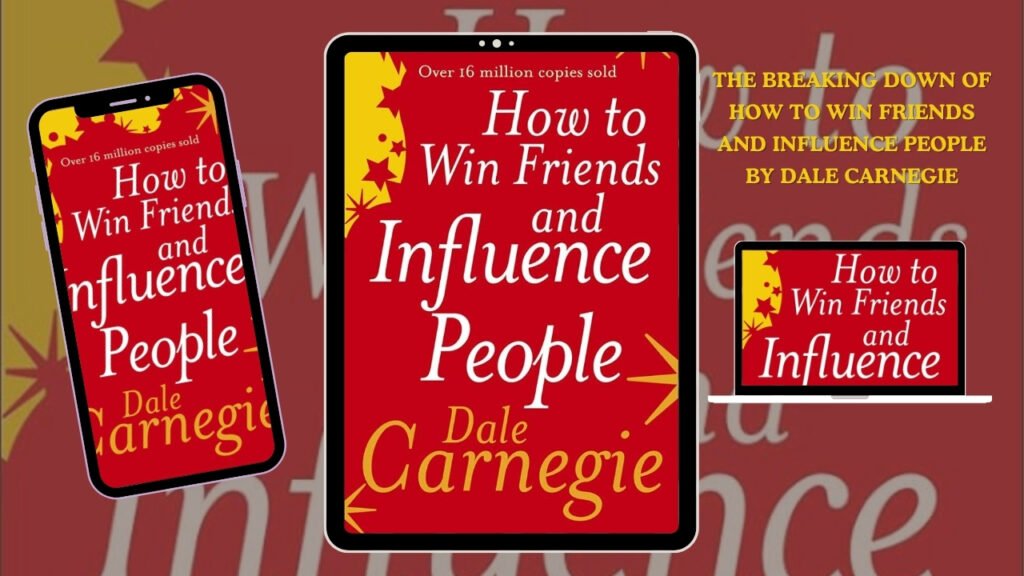Introduction
“How to Win Friends and Influence People.” First published in 1936, this book has weathered the storm of rapidly changing social landscapes from the formal, face-to-face interactions of the mid-20th century to today’s digital whirlwind of tweets and likes. What’s the secret to its enduring relevance? It turns out, Carnegie’s insights into human behavior are not just timeless they’re almost prophetic. In this post, we’ll dive into how these principles have not only persisted but thrived, transforming not just personal relationships but professional networks across generations. Ready to see how an old book can still teach new tricks? Let’s explore how Carnegie’s advice can be your lifeboat in today’s sea of network-building challenges.
Overview of the Book
Dale Carnegie’s guide offers deceptively simple yet immensely impactful advice on engaging with people, winning friends, shifting perspectives, and leading with authenticity by genuinely valuing others. This book isn’t about pulling strings from behind a curtain but about nurturing the foundations of positive relationships.
Instead of mere manipulation, Carnegie champions understanding and respect. For instance, consider the straightforward yet transformative practice of remembering people’s names. Imagine you’re at a bustling networking event, navigating a sea of faces. When you recall someone’s name from a previous brief encounter and use it, watch their expression light up a clear sign you’ve made them feel significant, not just another face in the crowd. This simple act can turn a forgettable interaction into a meaningful connection.
Let’s delve deeper into how Carnegie’s teachings can be applied across various situations today, making each interaction a stepping stone to stronger relationships. Ready to uncover how these age-old tips can still work wonders in your modern social and professional circles? Join me as we explore each facet of Carnegie’s timeless wisdom.
Key Concepts Discussed: Reimagined
1. Engaging with People Effectively: Forget the old notion of handling it’s about building bridges. Dale Carnegie kicks off with a universal truth: criticism tends to backfire. Imagine you criticize your partner’s way of organizing the garage. The result? Likely a cold shoulder, not gratitude. Carnegie suggests instead that we sprinkle our interactions with genuine appreciation, turning potential conflicts into opportunities for collaboration.
2. Six Ways to Make People Like You: Think of Carnegie’s advice as a secret recipe for charm that even the most socially awkward among us can master. For instance, one of his tips involves the simple act of smiling a gesture that can open doors and soften the hardest of hearts. Picture this: a new employee, previously unnoticed, starts greeting his team with a genuine smile each day and quickly finds himself welcomed into new projects and after-work gatherings.
3. How to Influence Others’ Thoughts: It’s not about mind control but about fostering mutual respect. Imagine you’re planning a family reunion. Instead of dictating the agenda, you seek everyone’s input and promptly acknowledge your oversight in forgetting Aunt May’s dietary restrictions. This approach not only smooths over potential upset but enhances cooperation.
4. Leadership Without Alienation: Carnegie’s leadership advice transcends the typical command-and-control paradigm. Instead of the boss who demands results without regard, imagine one who first acknowledges the team’s hard work before discussing areas for improvement. This strategy not only boosts morale but also encourages a more engaged and productive team.
By illustrating these principles with relatable scenarios, Carnegie’s wisdom comes alive, transforming abstract concepts into practical, everyday tools. Whether you’re looking to enhance your personal relationships or boost your professional life, these strategies offer a clear path to success. Ready to see how you can apply these ideas to turn everyday interactions into extraordinary opportunities? Let’s dive deeper into Carnegie’s transformative strategies!
Strengths and Weaknesses
Strengths:
– The principles are simple yet powerful if implemented with sincerity and empathy.
– Real-life examples and anecdotes make the concepts easy to understand and relate to.
Weaknesses:
– Some advice might seem dated, especially in the digital age where social interactions have evolved significantly.
– The techniques can come across as formulaic, which might lead to insincere application if one is not careful.
Personal Reflections: Deep Dive
Before diving into Dale Carnegie’s teachings, I’ll confess: I was skeptical. The idea that mere interpersonal tweaks could reshape my professional landscape seemed far-fetched. Yet, the transformation has been nothing short of remarkable. Let me paint you a picture.
The Before: Picture a typical office environment where interactions were transactional, often limited to “Can you send this?” or “Did you do that?” My interactions were no different efficient yet impersonal. Meetings were quiet, the air often filled with unspoken tensions and hurried nods rather than meaningful exchanges.
The Turning Point: On a whim, I decided to apply Carnegie’s principle of expressing genuine interest in others. It started with small steps asking about a colleague’s new puppy or another’s woodworking project. These weren’t just polite gestures; I genuinely wanted to know more. I listened, really listened.
The After: The change was gradual but undeniable. Those quiet meetings? They transformed into vibrant brainstorming sessions. Colleagues opened up, sharing not just personal anecdotes but also innovative ideas for projects we were working on. The atmosphere shifted from one of mere coexistence to active collaboration.
A Personal Triumph: One standout moment was with a colleague who had always been somewhat of an enigma to me. We had worked in parallel silos, often clashing without trying to understand each other’s viewpoints. One day, I asked about her photography, something I’d heard she loved. As she spoke, I saw her in a different light. Our relationship transformed, improving our teamwork and even leading to a joint project that became a huge success in our department.
Through these experiences, I’ve learned that Carnegie’s strategies aren’t just about making friends or influencing people in the shallow sense. They’re about forging genuine connections that can turn professional environments into places of mutual respect and shared success. This journey has taught me that the doors Carnegie opens are not just into the offices of our colleagues, but into their lives and ours, enriching them profoundly.
Real-World Applications: Revitalized
Dale Carnegie’s insight, “You can make more friends in two months by becoming interested in other people than you can in two years by trying to get other people interested in you,” perfectly captures the essence of modern social dynamics. This wisdom transcends traditional networking, where exchanges often felt like trading business cards in stuffy hotel conference rooms. Today, it’s about genuine engagement finding and connecting over shared interests that lead to meaningful relationships, both online and offline.
For the workplace: imagine transforming a routine group project. Instead of superficial interactions focused solely on task completion, you delve into understanding your teammates’ unique skills and passions. This not only enriches the project but also fosters a powerhouse team dynamic, where everyone feels valued and eager to contribute.
In personal friendships: this principle could redefine social interactions. Rather than dominating conversations with your latest adventures, you immerse yourself in learning about your friends’ hobbies and dreams. Such genuine interest can deepen bonds far beyond casual catch-ups, creating lasting friendships built on mutual respect and admiration.
Shifting focus from self-promotion to fostering genuine interest in others not only enhances personal connections but also brings psychological benefits. People naturally gravitate towards those who make them feel important and heard, creating an environment where openness and cooperation thrive. This altruistic approach isn’t just about being nice; it’s a strategic method for building robust networks that are both fulfilling and resilient.
Conclusion
Consider the challenge of leading a remote team where cultural nuances and time zones create complex dynamics. Carnegie’s principles of empathy and genuine interest can turn these potential obstacles into opportunities for building a cohesive and motivated team. Or, think about the often treacherous terrain of social media, where Carnegie’s advice to be understanding rather than confrontational can prevent conflicts and foster more meaningful interactions.
I challenge you, dear readers, to pick one of Carnegie’s strategies this week perhaps genuinely complimenting someone each day or actively listening more than you speak. Share your experiences, the successes, and the inevitable blunders, in the comments or on social media. Let’s embark on this experiment together, proving that small changes in our behavior can significantly enhance our interactions.
Dive into Carnegie’s strategies your next conversation could not only open doors but also pave new pathways you never anticipated. Let’s turn these timeless insights into modern-day victories in human connection. Ready to start the conversation? Share how you plan to use Carnegie’s advice in your life below!






